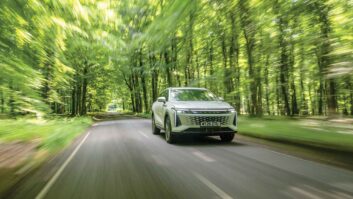I love driving. As soon as I was old enough to learn, the L-plates were fitted and I was heaving my Dad’s old Maxi around the corners of my local highways and byways without a care in the world.
I’m sure that for many of you, like me, driving is a hugely liberating experience. It expands your universe, freeing you to explore the world around you – including, of course, by towing a caravan.
I still love it today, 35 years or so on, but lately there’s been a bit of a niggle, something that’s made life on the road a little less fun. So what’s the problem?
In short, it’s headlight glare. Yes, the blinding lights from oncoming vehicles, particularly at dusk and at night – but sometimes even during the day – have made driving less comfortable and a touch more stressful, particularly when towing, even with one of the best tow cars.
It’s not just me finding our roads a bit too dazzling. Research conducted by the RAC in February 2025 revealed that almost all drivers surveyed said they find at least some car headlights too bright.

And an RAC survey in December 2024 showed that 61% of drivers who say they are affected by headlight glare believe the problem has got worse in just 12 months. The RAC’s study was based on 1866 UK drivers who hold a full, current, UK driving licence and drive at least once a month.
The AA has also surveyed drivers about glare, with equally troubling responses: 76% of those surveyed said they were blinded by the headlights of oncoming vehicles, and more than half (52%) had been dazzled by headlights from cars behind them.
This is often thought of as an older person’s issue, but the AA data suggest that’s not necessarily always the case, with 70% of 18-24-year-olds saying they had been blinded by oncoming headlights.
As the charts below show, glare is a serious problem affecting driver comfort and confidence. Since 2013, there were an average 280 collisions a year where dazzling headlights were a factor.

RAC senior policy officer Rod Dennis said: “With the exception of potholes, few motoring topics seem to rouse as much interest among the nation’s drivers right now as bright headlights. It’s indisputable that public concern is increasing, but the reasons for glare and what can be done to reduce it aren’t nearly as clear.”
The Department for Transport’s (DfT) position is that: “There is no evidence to suggest an underlying road safety issue associated with modern vehicle lighting; understandably there may be occasions where due to road geometry, the driver of an oncoming vehicle may experience temporary discomfort.”
“While we acknowledge the downward trend in police recorded collision statistics has not continued in recent years, there is absolutely no proven link to the advances in vehicle lighting technology.”

This was in a DfT report commissioned by Baroness Hayter, which prompted the research being done by TRL.
What causes headlight glare?
This is a complicated question, which hasn’t been fully answered, but among the contributory factors are:
- Headlight alignment: Are your headlights positioned correctly? It’s important that lights are positioned according to the manufacturer’s recommendations and the law of the land – if in doubt, seek advice from your garage. RAC data shows that of 32.4m MOTs carried out in 2022 on Class 4 vehicles in the UK, 1.6m failed owing to misaligned headlights.
- Higher vehicles: When they’re choosing the right tow car, many caravanners opt for higher SUV-type vehicles, so this affects caravanners and their reputation. More than half of drivers who have lower conventional vehicles believe those with higher vehicles are to blame. Be sure your own headlight alignment is correctly set.

- Lighting technology: Increasingly, new cars are fitted with LED headlights. These tend to give a brighter light than the more diffuse glow of a halogen bulb. But clearly, more research is required and possibly updated legislation, as Rod Dennis says: “All headlights have to meet specific international standards, which motorists might be surprised to discover haven’t been updated since the 1960s, so do not take specific account of newer technologies like xenon and LED.”
Ruling out medical problems
If you are experiencing problems with glare, it’s important to rule out medical problems with a trip to the optician.
Cataracts, for example, are a condition in which the lens in the eye clouds over, becoming less efficient at directing light and increasing sensitivity to bright light.
Glare could also be a sign of age-related macular degeneration. So if you are having glare issues, have your eye health checked out as a priority.
In the November 2022 edition of its journal Acuity, The College of Optometrists said its members were seeing an increasing number of patients who are no longer driving at night owing to headlight dazzle.
They also reported that many people believe they have a problem with their eyesight because they are blinded by headlights when in fact, their sight is fine.
Anecdotally, we have heard that older people find glare more of a problem, and leading optometrists Specsavers suggests that glare can worsen with age as our ability to adapt to light and dark slows down.

The Royal Society for the Prevention of Accidents says: “Between the ages of 15 and 65, the time it takes to recover from glare rises from one to nine seconds.” This may be a significant reason for many older people choosing not to drive at night.
Driving glasses have been suggested as a possible solution, but it’s important to take advice from a reputable optometrist. Don’t self-diagnose or buy products from online retailers without guidance.
While certain lenses can be used in certain situations, Specsavers states on its website that although some tinted and polarised lenses can help with glare during the day, they should not be used at night: “For driving at night, however, we do not recommend tinted lenses.”
Specsavers does advertise a single-vision UltraDrive Night lens made with a contrast-enhancing yellow tint, designed to help vision in low-light conditions, but again, you should seek proper advice from the optometrist before proceeding with such a solution.
Research is essential
Driving organisations such as the RAC and the AA have lobbied hard for more research into this problem, and in September 2024, questions were raised with the Transport Secretary, Heidi Alexander MP, in the House of Commons about whether there were any plans to fund independent research into the potential safety implications of headlight glare.
The DfT has since commissioned a comprehensive study into the problem of headlight glare, which is being conducted by leading transport researcher TRL.
The project has been running since October 2024 and is expected to be completed shortly. The research is using a modified car in practical trials to assess the conditions most likely to give rise to high brightness levels and glare, measuring factors such as traffic, weather conditions and ambient lighting.
Earlier this year, Liberal Democrat MP Martin Wrigley asked the Transport Secretary if she would make it policy to introduce measures to limit the brightness of LED car headlights.

Parliamentary Under-Secretary at the DfT Lilian Greenwood MP replied in March, stating: “All headlamps are designed and tested to international standards to ensure they are bright enough to light the road ahead but not so bright as to dazzle other road users.”
“The standards define the beam pattern and maximum and minimum light intensities. However, noting increased public concern, the Government has commissioned independent research to better understand the root causes of headlamp glare and develop potential countermeasures.”
“The work is underway and is due in summer 2025. The Government will consider carefully the outcome of that research to determine what action might be appropriate.”
TRL is scheduled to complete its research in the summer. The work aims to identify the sources of light to which a typical motorist is exposed – which could be other vehicles or infrastructure such as streetlights or traffic lights.
It will be fascinating to see the outcomes and recommendations that come from the TRL research.
What you can do to prevent being dazzled by headlight glare at night
- While cleaning a caravan is an important task for caravanners, don’t forget your car either, including keeping your windscreen clean and smudge-free to help prevent glare
- Ensure your spectacles are clean and smudge-free
- Have regular sight tests at your optometrist
- Don’t stare directly at the headlights of oncoming vehicles
- Be considerate and dip your headlights when required
While it may not help with headlight glare, having the best caravan sat nav can still play an important part in helping you have a stress-free experience on the road, taking the dimensions of your tourer into consideration to ensure you’re not confronted by any low bridges or narrow roads.
Another issue caravanners could find themselves facing on the road is a snaking tourer – check out our tips on how to deal with a snaking caravan to find out how to avoid it and what to do if it should occur.
Lead image: Getty Images
Future Publishing Limited, the publisher of Practical Caravan, provides the information in this article in good faith and makes no representation as to its completeness or accuracy. Individuals carrying out the instructions do so at their own risk and must exercise their independent judgement in determining the appropriateness of the advice to their circumstances. To the fullest extent permitted by law, neither Future nor its employees or agents shall have any liability in connection with the use of this information.
If you’ve enjoyed reading this article, why not get the latest news, reviews and features delivered direct to your door or inbox every month. Take advantage of our brilliant Practical Caravan magazine SUBSCRIBERS’ OFFER and SIGN UP TO OUR NEWSLETTER for regular weekly updates on all things caravan related.









